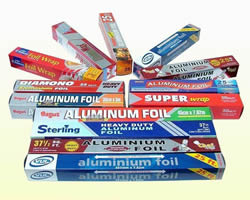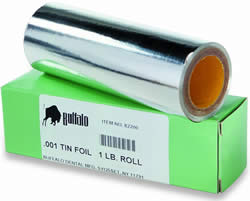Difference between Aluminum Foil and Tin Foil
Key Difference: Aluminum foil is a thin sheet of aluminum that is less than 0.2 millimeters in thickness and can be used for various different things around the house. Tin foil is a thin sheet of foil made from tin. This was the most common type of packaging and insulating material used before the World War II, following which aluminum became the cheapest material and went into mass production.
Aluminum foils and tin foils are two different types of packaging materials, but tin foils have now become of obsolete. Aluminum foils have become the more common packaging due to it being widely available. Tin foils are less sturdy and stiffer compared to aluminum and can also leave a bitter taste in the food. The confusion between the two arises from the term tin foil now being used to refer to aluminum foil, because of the similarities between the two.
 Aluminum foil is a thin sheet of aluminum that is less than 0.2 millimeters in thickness and can be used for various different things around the house. Aluminum sheets vary in thickness depending on what the foil is supposed to be used for. The most common foil that are available for commercial use are 0.016 millimeters thick, while heavy duty household foil is typically 0.024 millimeters. Aluminum is mostly used for packaging foods and other materials. Aluminum at home is used to keep the air from the fridge to contaminate the smell of the food, while others are used to packing the item. Aluminum foils are easy to tear and are often used with other materials such as plastic or paper wraps to ensure more sturdiness.
Aluminum foil is a thin sheet of aluminum that is less than 0.2 millimeters in thickness and can be used for various different things around the house. Aluminum sheets vary in thickness depending on what the foil is supposed to be used for. The most common foil that are available for commercial use are 0.016 millimeters thick, while heavy duty household foil is typically 0.024 millimeters. Aluminum is mostly used for packaging foods and other materials. Aluminum at home is used to keep the air from the fridge to contaminate the smell of the food, while others are used to packing the item. Aluminum foils are easy to tear and are often used with other materials such as plastic or paper wraps to ensure more sturdiness.
In addition to packaging, aluminum is also used for thermal insulation, cables and electronics because of its ability to conduct electricity. Aluminum foil is made by rolling aluminum sheet ingots casts, which are then re-rolled multiple times until the desired thickness is achieved. The sheets are applied heat but are cold-rolled to ensure it does not tear apart. The press machine has a sensor attached passes beta radiation through the foil to check the thickness of the foil and accordingly changes the process to either make the sheet thicker or thinner. The sheet is also lubricated to ensure that it does not become marked with a herringbone pattern. The lubricants usually burned-off during the heating and rolling process. When the thickness of the sheet is less than 0.025 mm, two layers are usually put together for the final pass and are later separated. The two sheets when separated results in one side of the foil sheet being shiny, while the other being matte. Aluminum sheets are used for storage, packaging, cooking and for many other household purposes, making it a pretty useful sheet to have around the house.
 Tin foil is a thin sheet of foil made from tin. This was the most common type of packaging and insulating material used before the World War II, following which aluminum became the cheapest material and went into mass production. Tin foil is actually much expensive and less durable compared to aluminum foil. The term tin foil has actually stuck, with many people still referring to aluminum foil as tin foil in the US and the UK. This is mostly because of the similarities between the two in appearance.
Tin foil is a thin sheet of foil made from tin. This was the most common type of packaging and insulating material used before the World War II, following which aluminum became the cheapest material and went into mass production. Tin foil is actually much expensive and less durable compared to aluminum foil. The term tin foil has actually stuck, with many people still referring to aluminum foil as tin foil in the US and the UK. This is mostly because of the similarities between the two in appearance.
In addition to tin foil, tin was also popular in cans. Tin foils were also used as a filling for tooth cavities before the 20th century. It was also used in recordings with the first audio recordings on phonograph cylinders were made on tin foil. These days, tin foils are used in electrical capacitors. Tin foils are made using a similar process to aluminum foils; the foil is rolled from a thin leaf of tin. Tin foils are actually stiffer than aluminum foil and can leave a bitter taste to food wrapped in it. Tin was replaced by aluminum in the 1910s, but the name tin foil is still widely used.
Image Courtesy: saffroninternational.co.in, papillondental.com









Add new comment